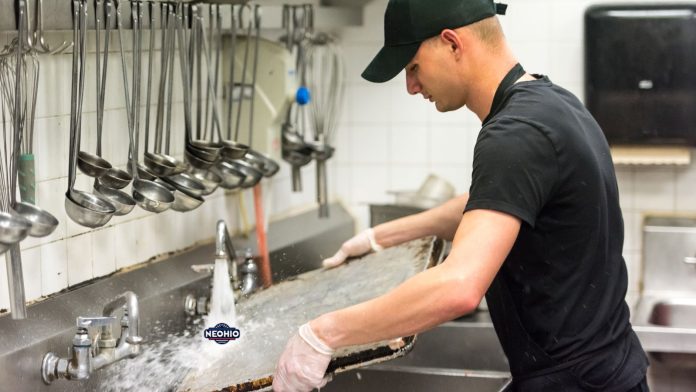Northeast Ohio’s restaurant scene is grappling with elevated vacancy rates as dining spaces across the region remain unfilled, creating challenges for both property owners and aspiring restaurateurs looking to break into the market.
The numbers show vacancy rates well above national norms. Cleveland city leads the region with 15.44% vacancy rate for retail space (which includes restaurants), while the east suburbs show 14% vacancy and west suburbs 11.8% vacancy rates.
For context, these numbers are significantly higher than national retail vacancy rates, which currently sit at just 4.1-5.3% nationally – actually near 20-year lows. Normal retail vacancy rates typically range from 5-10%, making Northeast Ohio’s elevated rates a clear challenge for the market.
Currently, there are 26 restaurant listings for lease available near Cleveland on major real estate platforms, with an average rent of $45 per square foot—significantly higher than standard retail space. The average restaurant space spans 8,163 square feet, though options range from intimate 1,718-square-foot bistros to massive 36,761-square-foot dining complexes.
However, these numbers tell only part of the story. Many landlords don’t bother listing their vacant restaurant properties on commercial real estate websites, instead opting for the old-school approach of putting up an “Available” sign and waiting for calls. This means the actual number of vacant restaurant spaces throughout Northeast Ohio is likely much higher than what shows up in online listings.
The Specialized Space Problem
What makes restaurant vacancies particularly challenging for landlords is the specialized nature of these spaces. Unlike a typical retail storefront that can be rented to virtually any business, restaurants require expensive commercial kitchen equipment, proper ventilation systems, and hood installations that can cost between $15,000 to $50,000 or more.
“When a restaurant closes, you’re not just losing a business—you’re losing a massive infrastructure investment,” explains Ryan Curtin, an Associate at Cushman & Wakefield | CRESCO Real Estate. “These spaces can sit empty for months or even years because the next tenant either needs to invest a fortune in kitchen buildout or find a space that’s already equipped.”
This creates a similar challenge to other specialized commercial spaces. Dental offices with built-in dental equipment, hair salons with specialized plumbing for shampoo stations, and medical facilities with examination rooms face the same problem—the landlord can’t simply rent to any retail business without significant modifications.
The result is that landlords with former restaurant spaces often find themselves in a difficult position: they can either wait for another restaurant tenant willing to use the existing kitchen infrastructure, invest heavily to convert the space back to general retail use, or accept significantly lower rents from tenants who need specialized space.
The Chain Restaurant Shift
Adding to the challenge for existing restaurant spaces is a significant trend in how new restaurants are opening. Major chains increasingly favor building their own freestanding locations rather than occupying existing restaurant spaces in strip malls or shopping centers.
According to recent industry data, over two-thirds of retail leasing activity in 2023 came from small tenants occupying less than 5,000 square feet on average. Food and beverage tenants, in particular, snapped up small strip spaces under 3,000 square feet, accounting for 20% of all leasing activity. However, the fastest-growing chains are often building new construction rather than filling vacant spaces.
Chains like Dave’s Hot Chicken (950 units in development nationally), Huey Magoo’s (250+ restaurants in development), and dozens of others are aggressively expanding—but they’re primarily choosing new construction over existing restaurant spaces. This trend reduces the pool of potential tenants for existing vacant restaurant spaces, though some chains do still occupy former restaurant locations. Locally, a new Dave’s Cosmic Subs recently opened in Fairview Park and a Wayback Burgers is coming to Stow, both taking over previous restaurant spaces.
“Chain restaurants are often built quicker than independent restaurants because many of the components are standardized,” notes industry construction data. The standardization allows chains to build efficient, purpose-built facilities rather than adapting existing spaces that may not meet their specific operational needs.
This leaves fewer potential tenants for the existing vacant restaurant spaces that landlords are trying to fill.
The Hood System and Licensing Bottleneck
One of the biggest barriers to filling vacant restaurant spaces is the commercial hood system requirement and complex licensing process. Every restaurant needs proper ventilation and fire suppression systems, known as Ansul hood systems, to meet health department and fire safety codes. But that’s just the beginning of the regulatory maze.
Commercial kitchens must also obtain multiple licenses and permits from various agencies including the health department, fire department, building department, and sometimes the liquor board. Each agency has specific requirements for equipment placement, electrical systems, plumbing, and safety protocols that can be expensive to retrofit in existing spaces.
“You can’t just walk into an empty retail space and start serving food,” notes a restaurant consultant familiar with the Northeast Ohio market. “The hood system alone can take months to install and costs more than many new restaurateurs have budgeted for their entire buildout.”
This has created a two-tier market where spaces with existing hood systems command premium rents, while empty retail spaces without kitchen infrastructure sit vacant longer as potential restaurant owners calculate the true cost of entry.
Ghost Kitchens Fill the Gap
Some entrepreneurs are bypassing traditional restaurant spaces entirely. CloudKitchens operates ghost kitchen facilities in Cleveland, offering fully equipped commercial kitchen space for delivery-only concepts. These facilities report an average basket size of $27 and handle about 1,109 deliveries per week.
“Ghost kitchens eliminate the dining room overhead while still providing professional kitchen facilities,” explains the trend toward delivery-focused food businesses. “You get the commercial hood systems, the professional equipment, and none of the front-of-house expenses.”
Regional Variations Tell the Story
The vacancy challenge isn’t hitting all areas equally. While Cleveland proper struggles with the highest vacancy rates, some suburban markets are faring better:
- Lake County: 13.59% vacancy (up from 10.19%)
- Lorain County: 13.12% vacancy (down slightly from 13.9%)
- Portage County: 12.75% vacancy (up from 9.3%)
- Geauga County: 10.56% vacancy (up from 9.18%)
The variation often correlates with local economic conditions, population density, and the presence of major employers who provide a customer base for restaurants.
What’s Driving the Challenge
Several factors are converging to create the current vacancy situation:
- Rising commercial rents outpacing restaurant profit margins
- Labor shortage making it difficult to staff restaurants adequately
- Supply chain costs increasing food and beverage expenses
- Changing dining habits with more consumers preferring delivery and takeout
- High barrier to entry for new restaurants due to equipment and buildout costs
- Chain preference for new construction reducing the pool of potential tenants
The Ripple Effect
Empty restaurant spaces don’t just represent lost businesses—they create dead zones in commercial districts that are particularly hard for landlords to fill. Restaurants typically generate foot traffic that benefits neighboring retailers, and their absence can accelerate the decline of entire shopping areas.
“When you lose the anchor restaurant in a strip plaza, it affects everyone,” observes a commercial property manager. “Restaurants bring people out, especially in the evenings. Without that draw, other businesses suffer too.”
The challenge extends beyond restaurants to other specialized spaces. When salons close, landlords face similar difficulties—the specialized plumbing for shampoo stations and hair washing areas limits potential tenants. Dental offices present even greater challenges, with built-in dental equipment, specialized electrical requirements, and medical waste considerations that make conversion to general retail nearly impossible without substantial investment.
These specialized spaces often require landlords to either wait for tenants in the same industry or undertake expensive renovations to make the space suitable for general retail use.
The Path Forward
Industry experts suggest the elevated restaurant vacancy rates may persist until several conditions improve: commercial rents stabilize, labor markets recover, and supply chain costs normalize. In the meantime, the spaces that do find tenants are likely to be those offering the best value proposition—either through lower rents, existing kitchen infrastructure, or flexible lease terms.
For aspiring restaurant owners, the message is clear: factor in the total cost of entry, including potential hood system installation and licensing requirements, when evaluating vacant restaurant spaces. The sticker price for rent is just the beginning of the financial commitment required to bring these empty dining rooms back to life.
Discover more from Northeast Ohio News
Subscribe to get the latest posts sent to your email.











